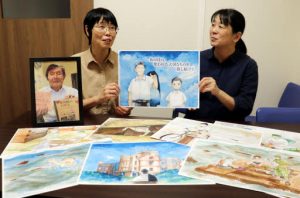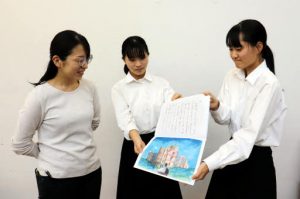Striving to fill voids in Hiroshima 76 years after the atomic bombing—Life of A-bomb orphan child is captured in picture-story show depicting his wish of seeing his parents again
Oct. 12, 2021
Students at Motomachi Senior High School create show; news of death comes soon after completion
by Rina Yuasa, Staff Writer
On October 3, the workplace called “I Love Sagyosho,” which employs hearing-impaired people with multiple disabilities and is located in Hiroshima’s Naka Ward, held a festival at the Municipal Yoshijima Welfare Center, also located in Naka Ward. In the festival, a picture-story show was used to communicate the experiences of the late Masao Tanaka, an A-bomb orphan child who had worked at the workplace but who died earlier this year, on July 28.
Ever since he became separated from his family at the time of the atomic bombing, Mr. Tanaka continued searching for his family. His life’s story was turned into the picture-story show, painstaking work carried out by students at Motomachi Senior High School, located in Hiroshima’s Naka Ward. At the festival, the picture-story show illustrations were projected onto a screen in the form of a slide show. The oral reading of the show’s script, recorded by the students prior to the event, was streamed to coincide with timing of the slide show, with sign-language interpretation provided by Miyuki Yamaguchi, 59, a resident of Hatsukaichi City and member of the non-profit organization “Hiroshima Prefecture Sign-language Interpretation Study Group.”
To prevent any spread of the coronavirus, the festival did not allow participation by the public. The audience directly involved in the event numbered about 60 people who spent time recalling Mr. Tanaka’s life. Tomoe Kurokawa, 88, an A-bomb survivor and employee of the workplace, said, “He always talked about how he wanted to see his parents again. I became quite emotional while watching the picture-story show.”
Mr. Tanaka passed away at estimated age of 80 without ever knowing his real name
Seventy-six years ago, around the age at which he began to be able to discern things around him, Masao Tanaka was separated from his family and orphaned in the chaotic situation following the atomic bombing. He had a hearing impairment and also was unaware of his real name or birthdate. He died at an estimated age of 80 after spending his life desperately seeking his parents’ whereabouts. His death came just after the students had finished creating the picture-story show depicting his life and just before he had a chance to see the event.
The picture-story show’s title is “My continued search for precious things I lost that day.” The show consists of 12 watercolor paintings, which carefully depict his life, including episodes in which he suddenly found himself trapped under tatami mats at home, fell into the river as he had tried to crawl out from under the tatami, and when he was saved after being plucked from the river and placed on a raft.
The creation of the picture-story show got its start when Hiromi Okimoto, 59, head of the I Love Sagyosho organization, where Mr. Tanaka had worked, spoke with the interpreter Ms. Yamaguchi about whether there was any way to pass on Mr. Tanaka’s experiences to others. Ms. Yamaguchi came up with the idea of a picture-story show, based on the idea that anyone, including children, adults, hearing-abled people, and hearing-impaired persons could see it together. She discussed her idea with people at Motomachi Senior High School, at which students engage in the creation of A-bomb paintings.
In the winter of 2019, Miki Okamoto, 18, and Miharu Okabe, 18, who were then first-year students in a creative expression course at the school, initiated the work. Meeting with Mr. Tanaka, the students showed him their tentative illustrations for the show. The three of them devised a script for the story together based on the interpretation of Ms. Yamaguchi’s sign language. Ms. Okabe said, “I wanted to express the fears he felt at the time when he was completely unaware of what happened to him because he couldn’t hear sound.” Ms. Okamoto said, “I tried to put myself in his shoes and countless times imagine his experience of never being with his family.”
After the atomic bombing, Mr. Tanaka was placed in a home for war orphans at the Hijiyama National School (now Hijiyama Elementary School in Hiroshima’s Minami Ward). Masami Ishida, then director of the home, wrote, “Ms. Takayama (teacher) named this child ‘Masao Tanaka.’” In the following year, he was moved to the Hiroshima War Orphans Foster Home (located in present-day Saeki Ward), and worked at a fusuma (paper sliding door) retail shop after graduating from a school for the hearing impaired.
As an A-bomb orphan and hearing-impaired child, Mr. Tanaka tried hard at life despite his difficulties and married when he was 45. After retiring, he began to visit the I Love Sagyosho workplace and was surrounded by like-minded people. Ms. Okimoto said, “Mr. Tanaka’s facial expressions described in the picture-story show illustrations were identical to those I remember of him. He was always cheerful and liked to make others laugh.” His signature pose of slinging a jacket over his shoulder in imitation of Yujiro Ishihara, an actor he admired, is also described in the picture-story show.
About ten days after Ms. Yamaguchi received the completed picture-story show illustrations from the high school, however, she heard the news about the death of Mr. Tanaka following his hospitalization. “He was looking forward to completion of the picture-story show illustrations. I wanted to make him happy with the show,” said Ms. Yamaguchi. On the morning of the day of the funeral, she showed the illustrations one by one to his peaceful countenance as he lay in a coffin, conveying to him that the show had been completed.
Every year on August 6, Mr. Tanaka would walk around Hiroshima Peace Memorial Park, hoping that his relatives would be able to find him among the crowds. He would ask Ms. Okimoto to come with him to the park because he thought communicating with her in sign language might attract the attention of someone looking for him, and there they continued using their hands that way. In the picture-story show, the protagonist says, “I am still looking for ‘me.’ I want to see my father and mother. I really want to see them. And I will keep on searching for them.”
Mr. Tanaka was never able to fill his own void caused by the atomic bombing with his real name, age, or family. He continued, however, to look ahead and live his life positively. His determination is illustrated by the words in the picture-story show, “In the future, I will continue to live my life as Masao Tanaka.” Through illustrations, sign language, and vocalizations, his wish while alive will be passed on to others.
(Originally published on October 12, 2021)









